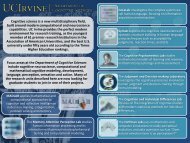Conscious Realism and the Mind-Body Problem - UCI Cognitive ...
Conscious Realism and the Mind-Body Problem - UCI Cognitive ...
Conscious Realism and the Mind-Body Problem - UCI Cognitive ...
Create successful ePaper yourself
Turn your PDF publications into a flip-book with our unique Google optimized e-Paper software.
<strong>Conscious</strong> <strong>Realism</strong> <strong>and</strong> <strong>the</strong> <strong>Mind</strong>-<strong>Body</strong> <strong>Problem</strong> 103problem. <strong>Conscious</strong> realism is a proposed answer to <strong>the</strong> question of what<strong>the</strong> universe is made of. <strong>Conscious</strong> realism asserts that <strong>the</strong> objective world,i.e., <strong>the</strong> world whose existence does not depend on <strong>the</strong> perceptions of aparticular observer, consists entirely of conscious agents.<strong>Conscious</strong> realism is a non-physicalist monism. What exists in <strong>the</strong>objective world, independent of my perceptions, is a world of consciousagents, not a world of unconscious particles <strong>and</strong> fields. Those particles <strong>and</strong>fields are icons in <strong>the</strong> MUIs of conscious agents, but are not <strong>the</strong>mselvesfundamental denizens of <strong>the</strong> objective world. <strong>Conscious</strong>ness is fundamental.It is not a latecomer in <strong>the</strong> evolutionary history of <strong>the</strong> universe, arisingfrom complex interactions of unconscious matter <strong>and</strong> fields. <strong>Conscious</strong>nessis first; matter <strong>and</strong> fields depend on it for <strong>the</strong>ir very existence. So <strong>the</strong>terms “matter” <strong>and</strong> “consciousness” function differently for <strong>the</strong> consciousrealist than <strong>the</strong>y do for <strong>the</strong> physicalist. For <strong>the</strong> physicalist, matter <strong>and</strong>o<strong>the</strong>r physical properties are ontologically fundamental; consciousness isderivative, arising from or identified with complex interactions of matter.For <strong>the</strong> conscious realist, consciousness is ontologically fundamental;matter is derivative, <strong>and</strong> among <strong>the</strong> symbols constructed by consciousagents.According to conscious realism, when I see a table, I interact with asystem, or systems, of conscious agents, <strong>and</strong> represent that interaction inmy conscious experience as a table icon. Admittedly, <strong>the</strong> table gives melittle insight into those conscious agents <strong>and</strong> <strong>the</strong>ir dynamics. The table isa dumbed-down icon, adapted to my needs as a member of a species in aparticular niche, but not necessarily adapted to give me insight into <strong>the</strong>true nature of <strong>the</strong> objective world that triggers my construction of <strong>the</strong>table icon. When, however, I see you, I again interact with a consciousagent, or a system of conscious agents. And here my icons give deeperinsight into <strong>the</strong> objective world: <strong>the</strong>y convey that I am, in fact, interactingwith a conscious agent, namely you.<strong>Conscious</strong> realism is not panpsychism nor does it entail panpsychism.Panpsychism claims that all objects, from tables <strong>and</strong> chairs to <strong>the</strong> sun<strong>and</strong> moon, are <strong>the</strong>mselves conscious (Hartshorne 1937/1968, Whitehead1929/1979), or that many objects, such as trees <strong>and</strong> atoms, but perhapsnot tables <strong>and</strong> chairs, are conscious (Griffin 1998). <strong>Conscious</strong> realism,toge<strong>the</strong>r with MUI <strong>the</strong>ory, claims that tables <strong>and</strong> chairs are icons in <strong>the</strong>MUIs of conscious agents, <strong>and</strong> thus that <strong>the</strong>y are conscious experiences ofthose agents. It does not claim, nor entail, that tables <strong>and</strong> chairs are consciousor conscious agents. By comparison, to claim, in <strong>the</strong> virtual-tennisexample, that a supercomputer is <strong>the</strong> objective reality behind a tennisballicon is not to claim that <strong>the</strong> tennis-ball icon is itself a supercomputer.The former claim is, for purposes of <strong>the</strong> example, true but <strong>the</strong> latter isclearly false.<strong>Conscious</strong> realism is not <strong>the</strong> transcendental idealism of Kant (1781/







